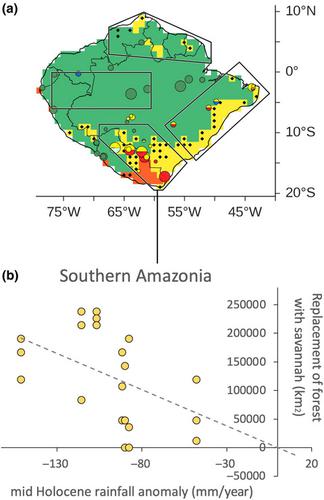当前位置:
X-MOL 学术
›
Glob. Change Biol.
›
论文详情
Our official English website, www.x-mol.net, welcomes your
feedback! (Note: you will need to create a separate account there.)
Response of Amazonian forests to mid-Holocene drought: A model-data comparison
Global Change Biology ( IF 10.8 ) Pub Date : 2021-10-15 , DOI: 10.1111/gcb.15929 Richard J Smith 1 , Joy S Singarayer 2 , Francis E Mayle 1
Global Change Biology ( IF 10.8 ) Pub Date : 2021-10-15 , DOI: 10.1111/gcb.15929 Richard J Smith 1 , Joy S Singarayer 2 , Francis E Mayle 1
Affiliation

|
There is a major concern for the fate of Amazonia over the coming century in the face of anthropogenic climate change. A key area of uncertainty is the scale of rainforest dieback to be expected under a future, drier climate. In this study, we use the middle Holocene (ca. 6000 years before present) as an approximate analogue for a drier future, given that palaeoclimate data show much of Amazonia was significantly drier than present at this time. Here, we use an ensemble of climate and vegetation models to explore the sensitivity of Amazonian biomes to mid-Holocene climate change. For this, we employ three dynamic vegetation models (JULES, IBIS, and SDGVM) forced by the bias-corrected mid-Holocene climate simulations from seven models that participated in the Palaeoclimate Modelling Intercomparison Project 3 (PMIP3). These model outputs are compared with a multi-proxy palaeoecological dataset to gain a better understanding of where in Amazonia we have most confidence in the mid-Holocene vegetation simulations. A robust feature of all simulations and palaeodata is that the central Amazonian rainforest biome is unaffected by mid-Holocene drought. Greater divergence in mid-Holocene simulations exists in ecotonal eastern and southern Amazonia. Vegetation models driven with climate models that simulate a drier mid-Holocene (100–150 mm per year decrease) better capture the observed (palaeodata) tropical forest dieback in these areas. Based on the relationship between simulated rainfall decrease and vegetation change, we find indications that in southern Amazonia the rate of tropical forest dieback was ~125,000 km2 per 100 mm rainfall decrease in the mid-Holocene. This provides a baseline sensitivity of tropical forests to drought for this region (without human-driven changes to greenhouse gases, fire, and deforestation). We highlight the need for more palaeoecological and palaeoclimate data across lowland Amazonia to constrain model responses.
中文翻译:

亚马逊森林对全新世中期干旱的响应:模型数据比较
面对人为气候变化,亚马逊在下个世纪的命运令人担忧。一个关键的不确定性领域是在未来干燥的气候下预期的雨林枯死规模。在这项研究中,我们使用全新世中期(大约 6000 年前)作为未来更干燥的近似模拟,因为古气候数据显示亚马逊河的大部分地区此时比现在明显干燥。在这里,我们使用一组气候和植被模型来探索亚马逊生物群落对全新世中期气候变化的敏感性。为此,我们采用了三个动态植被模型(JULES、IBIS 和 SDGVM),这些模型由来自参与古气候建模比对项目 3 (PMIP3) 的七个模型的偏差校正的全新世中期气候模拟强制。将这些模型输出与多代理古生态数据集进行比较,以更好地了解亚马逊地区我们对全新世中期植被模拟最有信心的地方。所有模拟和古数据的一个重要特征是亚马逊雨林中部生物群落不受全新世中期干旱的影响。亚马逊河东部和南部生态群落中全新世中期模拟的差异更大。由模拟全新世中期较干燥(每年减少 100-150 毫米)的气候模型驱动的植被模型可以更好地捕捉这些地区观察到的(古数据)热带森林枯死。根据模拟降雨量减少与植被变化之间的关系,我们发现有迹象表明亚马逊河流域南部热带森林的枯死率为~125,000 km 所有模拟和古数据的一个重要特征是亚马逊雨林中部生物群落不受全新世中期干旱的影响。亚马逊河东部和南部生态群落中全新世中期模拟的差异更大。由模拟全新世中期较干燥(每年减少 100-150 毫米)的气候模型驱动的植被模型可以更好地捕捉这些地区观察到的(古数据)热带森林枯死。根据模拟降雨量减少与植被变化之间的关系,我们发现有迹象表明亚马逊河流域南部热带森林的枯死率为~125,000 km 所有模拟和古数据的一个重要特征是亚马逊雨林中部生物群落不受全新世中期干旱的影响。亚马逊河东部和南部生态群落中全新世中期模拟的差异更大。由模拟全新世中期较干燥(每年减少 100-150 毫米)的气候模型驱动的植被模型可以更好地捕捉这些地区观察到的(古数据)热带森林枯死。根据模拟降雨量减少与植被变化之间的关系,我们发现有迹象表明亚马逊河流域南部热带森林的枯死率为~125,000 km 由模拟全新世中期较干燥(每年减少 100-150 毫米)的气候模型驱动的植被模型可以更好地捕捉这些地区观察到的(古数据)热带森林枯死。根据模拟降雨量减少与植被变化之间的关系,我们发现有迹象表明亚马逊河流域南部热带森林的枯死率为~125,000 km 由模拟全新世中期较干燥(每年减少 100-150 毫米)的气候模型驱动的植被模型可以更好地捕捉这些地区观察到的(古数据)热带森林枯死。根据模拟降雨量减少与植被变化之间的关系,我们发现有迹象表明亚马逊河流域南部热带森林的枯死率为~125,000 km全新世中期每 100 毫米降雨量减少2次。这提供了该地区热带森林对干旱的基线敏感性(没有人类驱动的温室气体变化、火灾和森林砍伐)。我们强调需要更多的亚马逊低地古生态和古气候数据来限制模型响应。
更新日期:2021-12-03
中文翻译:

亚马逊森林对全新世中期干旱的响应:模型数据比较
面对人为气候变化,亚马逊在下个世纪的命运令人担忧。一个关键的不确定性领域是在未来干燥的气候下预期的雨林枯死规模。在这项研究中,我们使用全新世中期(大约 6000 年前)作为未来更干燥的近似模拟,因为古气候数据显示亚马逊河的大部分地区此时比现在明显干燥。在这里,我们使用一组气候和植被模型来探索亚马逊生物群落对全新世中期气候变化的敏感性。为此,我们采用了三个动态植被模型(JULES、IBIS 和 SDGVM),这些模型由来自参与古气候建模比对项目 3 (PMIP3) 的七个模型的偏差校正的全新世中期气候模拟强制。将这些模型输出与多代理古生态数据集进行比较,以更好地了解亚马逊地区我们对全新世中期植被模拟最有信心的地方。所有模拟和古数据的一个重要特征是亚马逊雨林中部生物群落不受全新世中期干旱的影响。亚马逊河东部和南部生态群落中全新世中期模拟的差异更大。由模拟全新世中期较干燥(每年减少 100-150 毫米)的气候模型驱动的植被模型可以更好地捕捉这些地区观察到的(古数据)热带森林枯死。根据模拟降雨量减少与植被变化之间的关系,我们发现有迹象表明亚马逊河流域南部热带森林的枯死率为~125,000 km 所有模拟和古数据的一个重要特征是亚马逊雨林中部生物群落不受全新世中期干旱的影响。亚马逊河东部和南部生态群落中全新世中期模拟的差异更大。由模拟全新世中期较干燥(每年减少 100-150 毫米)的气候模型驱动的植被模型可以更好地捕捉这些地区观察到的(古数据)热带森林枯死。根据模拟降雨量减少与植被变化之间的关系,我们发现有迹象表明亚马逊河流域南部热带森林的枯死率为~125,000 km 所有模拟和古数据的一个重要特征是亚马逊雨林中部生物群落不受全新世中期干旱的影响。亚马逊河东部和南部生态群落中全新世中期模拟的差异更大。由模拟全新世中期较干燥(每年减少 100-150 毫米)的气候模型驱动的植被模型可以更好地捕捉这些地区观察到的(古数据)热带森林枯死。根据模拟降雨量减少与植被变化之间的关系,我们发现有迹象表明亚马逊河流域南部热带森林的枯死率为~125,000 km 由模拟全新世中期较干燥(每年减少 100-150 毫米)的气候模型驱动的植被模型可以更好地捕捉这些地区观察到的(古数据)热带森林枯死。根据模拟降雨量减少与植被变化之间的关系,我们发现有迹象表明亚马逊河流域南部热带森林的枯死率为~125,000 km 由模拟全新世中期较干燥(每年减少 100-150 毫米)的气候模型驱动的植被模型可以更好地捕捉这些地区观察到的(古数据)热带森林枯死。根据模拟降雨量减少与植被变化之间的关系,我们发现有迹象表明亚马逊河流域南部热带森林的枯死率为~125,000 km全新世中期每 100 毫米降雨量减少2次。这提供了该地区热带森林对干旱的基线敏感性(没有人类驱动的温室气体变化、火灾和森林砍伐)。我们强调需要更多的亚马逊低地古生态和古气候数据来限制模型响应。











































 京公网安备 11010802027423号
京公网安备 11010802027423号